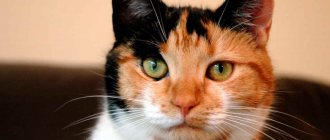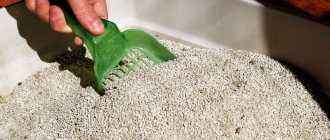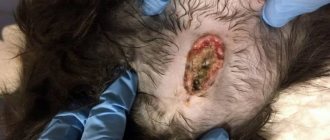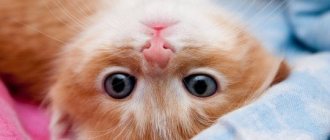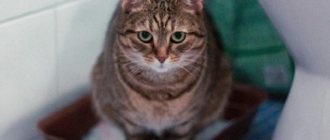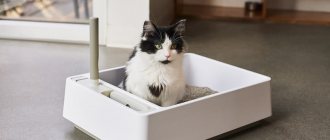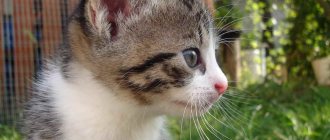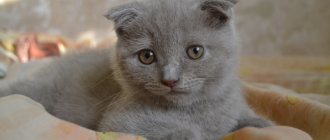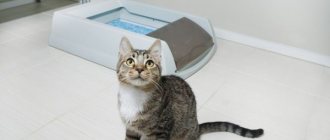It is important for cats to urinate regularly for their bladder and overall health. However, if you are going to be traveling with your cat for an extended period of time, you may be wondering how long she can go without peeing. Although cats generally take good care of themselves, they should not go more than 24 hours without urinating.
Here's what you need to know about your cat's bladder health, and steps you can take to keep them healthy and happy.
The cat does not go to the toilet after moving
As in the situation with food, the best recommendation in this case for animal owners is to simply wait.
But to prevent your pet from crap in your new apartment, we recommend: If your pet hides in a corner, you need to place an old litter tray not far from it. If you want to place the tray in a different place in the future, you can accustom your cat to this after the pet’s stress has passed.
If the cat went to the toilet in the wrong place, you need to reproach him, do not let him get used to such permissiveness.
Don’t forget to cover from potential “damage” all the furniture in the house that could absorb the smell if the animal doesn’t immediately go where to go to the toilet.
As with food, a cat in a new place may not go to the toilet for 3-4 days due to stress. This is quite common practice. If you create comfortable conditions for him to go to the toilet by placing his tray nearby, he will certainly do it.
How to determine that a kitten wants to go to the toilet?
Many inexperienced owners are afraid that they will not be able to determine when the kitten wants to poop. If a cat scratches the surface with its paws, the owner should transfer it to the tray as soon as possible. Usually the kitten understands from the first time what is required of him.
Another way to determine that a cat wants to go to the litter box is this behavior when he seems to sniff around, as if looking for a place. It is also worth looking at the pet’s eyes; if the owner sees that the cat seems to be glazed over, then he is definitely thinking about his goal. As soon as the cat begins to show such signs, it means that she wants to poop.
Why do veterinarians say different things?
Each veterinarian has his own point of view and his own level of knowledge, which is why they advise differently. Often this advice is harmful. This happens because feline nutrition is a subtle and new science: it is not studied in sufficient detail in veterinary schools. Yes, and everyone studied differently: some were excellent students, while others bounced from two to three.
Then doctors graduate and begin additional training at seminars and conferences, which are usually sponsored by feed manufacturers. As a result, doctors are provided with not entirely correct data and are mainly taught how to select medicinal foods in a given situation. Veterinarians come out of these seminars and begin to prescribe food to patients, as they were taught, but they cannot really advise on natural nutrition.
And often, after attending such seminars, veterinarians prescribe cereals, because this is what food manufacturers teach: the reason for this is purely commercial - manufacturers add grains to food in order to make the product as cheap as possible and put more money in their pocket. But this needs to be justified, which is why a theoretical basis is provided for the need for the presence of grains in the diet of cats.
At the same time, a veterinarian who knows little about cat nutrition can be an excellent diagnostician or surgeon. It’s just that dietetics is a separate topic and you shouldn’t judge a veterinarian by it.
Ways to fight at home
If the owners understand that the pet has settled into a new place, is behaving cheerfully and actively, but still has not performed an act of defecation, measures should be taken. When a kitten does not walk for 3 days or more, you need to carefully feel its tummy. This is due to the fact that constipation is often accompanied by bloating and pain.
Of course, any inexperienced owner has a question about how to understand that it is painful for a kitten to defecate. In such situations, the pet may walk near the tray for a long time and squeak pitifully. Sometimes it happens that feces are visible from the anus. In particularly difficult cases, the help of a specialist is required. In the modern world, calling a veterinarian to your home is not problematic, but you can try to help your pet yourself.
Oil and soap
Vegetable oil is an excellent remedy for constipation; it is suitable for both kittens and adults. If your pet does not go to the toilet for several days, this product will help significantly alleviate his condition.
However, there is no need to give a lot of oil; ½ tsp per day will be enough. The most convenient way to give it to a kitten is through a syringe without a needle. It should be poured slowly so that the animal does not choke. After such manipulations, bowel movements will occur without any problems.
In addition, a little oil can be mixed into the food. However, you should not abuse this method, because excessive consumption of this product can adversely affect the liver. Your pet should go to the toilet regularly as a result of proper nutrition, and not because of the addition of any special ingredients.
Using soap can also relieve your pet from constipation. To do this, cut off a small piece and then give it a round shape. The resulting candle must be moistened with water and inserted into the kitten’s anus.
Of course, the animal will not like this procedure, so it is recommended to do it while the pet is sleeping. This remedy will take effect within a few hours.
Cleansing enema
If your pet has been suffering from constipation for several days, you can give him an enema.
However, this procedure should be carried out with extreme caution. You need to take warm boiled water, as well as a 10 ml syringe
For convenience, the manipulation should be carried out by two people so that one holds the animal, and the other carefully introduces water. The syringe must be inserted quite deeply so that the liquid does not spill out. The tip can be pre-lubricated with Vaseline.
The pet's tummy must be periodically palpated to monitor the filling of the intestines. However, you should not press hard; light touches will be enough.
The enema must be done very carefully, especially if the owner has no experience. The best option is to go to a veterinary clinic, where specialists will provide qualified assistance.
Massage treatments
An animal that cannot empty its bowels on its own is in dire need of help from its owners. This is especially true for kittens whose mother has refused proper care.
Helping your pet is quite simple; it is important to follow certain recommendations for babies aged from birth to 10-12 weeks:
- First of all, you need to position the baby comfortably. It is best to place it on your left hand, turning its tail towards the owner. You should not put excessive pressure on the fragile body, but you still need to apply effort to minimize the risk of loss.
- You should prepare in advance a clean piece of cloth or a wet wipe that will be needed to stimulate the anus. This procedure is necessary to replace the natural process, which is often carried out by the mother.
- Then take a napkin with your right hand and make circular movements in the area of the kitten’s anus. After stimulating the animal’s anus, the muscles will relax, because such manipulations will imitate the licking of a cat.
- It is advisable to perform a massage daily for 1-2 minutes. If the animal still cannot go to the toilet, you should seek help from a veterinarian.
These manipulations will have a positive effect on the condition of the kitten. First of all, massage helps to establish intestinal motility and increase blood circulation. In addition, the pet will learn to trust the owner, perceiving him as a mother cat. If the desired effect is achieved, you need to carefully wipe the animal's butt without damaging the anus.
Helping your pet with constipation
Treating constipation in a cat at home is possible only if it is not caused by a serious illness. Therefore, it is important to have your cat examined by a veterinarian as soon as possible.
If the cause of constipation is known, the issue of establishing bowel movements can be resolved in several ways.
Adjusting the animal's diet
If your cat suffers from constipation periodically, it is necessary to choose food marked i/d. They are designed specifically for animals that have problems with defecation. For example, Hills Prescription Diet Feline wd, Royal Canin Fiber Response, Purina Veterinary Diets OM. They are used in courses or given to the cat on an ongoing basis. Natural fats, high-quality proteins, a large amount of fiber, prebiotics, which are contained in specialized feeds, help to establish intestinal motility and soften stool.
In addition, diet correction occurs as follows:
- Give more liquid. Access to clean water should always be open.
- Fermented milk products or plain milk help well. Sour milk helps improve the functioning of the gastrointestinal tract.
- For constipation, it is better to remove dry food from the diet and introduce wet food instead. It should be given in small portions.
- It is recommended to make homemade food in the form of puree (meat, fish, liver) with a large amount of broth.
- Vegetable feeding is required. You need to add chopped raw beets and carrots to your daily meals. If the animal refuses to eat such food, you can add juice.
- Massage your cat's belly daily in a clockwise direction, applying gentle pressure. It is necessary to adjust the diet.
IMPORTANT! The products that the cat eats should stimulate the intestines, not cause bloating, and be maximally saturated with microelements, water, and vitamins.
Use of oils
Oils (vaseline, castor, vegetable) soften feces and facilitate their easy removal from the body. When choosing vegetable oils, you should pay attention to hemp or olive oils, which are added in small quantities to wet food. They are not recommended to be given frequently, as they put a lot of strain on the liver.
Castor and petrolatum oil for constipation also help relieve the cat from suffering. The procedure is carried out on an empty stomach. 2 ml of oil is poured into the animal’s mouth. The cat should not be fed for the next 2 hours. The intestines empty after 3-5 hours.
IMPORTANT! Vaseline oil does not accumulate in the body, so it is not dangerous for the animal. You should be careful with castor oil. It causes stomach pain in some cats.
Laxatives
If your cat is constipated, laxatives can solve the question of what to do. Veterinarians usually advise using gentle agents administered orally.
These include:
- Lactusan is a prebiotic that copes well with constipation in animals by restoring intestinal microflora and activating intestinal motility.
- Duphalac is a lactulose-based drug that improves intestinal motility.
- Prelax is a lactulose syrup that quickly relieves constipation in animals.
Magnesium sulfate is a medicine in powder form that is diluted in water and poured into the animal’s mouth using a syringe. Begins to act after 6 hours.
ADVICE! A laxative should be given only after consultation with a veterinarian, after examining the cat and determining the causes of constipation. Otherwise, you can only worsen the cat’s condition.
Enema for constipation in cats
Treatment of constipation in cats with an enema is possible only after examination by a veterinarian. In case of chronic diseases and obstruction, it is prohibited to install it!
The enema liquid is a slightly salted solution of water or chamomile infusion, the temperature of which should not exceed 30 degrees. Before the procedure, you need to give Vaseline oil. Take a small syringe, fill it with 180-200 ml of warm solution, and lubricate the tip with Vaseline. Carefully insert the syringe into the cat's anus 1.5 cm and pour in the solution. Take out the syringe and immediately press the tail to the anus. You can gently massage your pet's belly in a clockwise direction. After 10-30 minutes, emptying should occur.
Veterinarians do not recommend giving cats an enema if they have hemorrhoids, cracks in the anus and rectum, the presence of worms, during pregnancy, or if they have heart disease. Otherwise, the procedure will lead to a deterioration in the animal’s condition.
How to deal with a delicate pet problem at home?
Attentive owners will always notice changes in the behavior of an adult cat or kitten. Kittens need the most care. When a kitten does not go to the toilet for a long time, it becomes lethargic, stops eating, sits on the tray longer than usual, but cannot squeeze anything out. When a kitten does not poop, its activity and playfulness are lost, it looks very sad and causes aching pity. Constipation can be treated at home.
Furry babies are helped to poop by their moms by being licked. If constipation occurs in a kitten that was taken from its mother early (less than a month), replace it with her: massage, stroke the entire tummy from top to bottom
For a while, protect him from “increased child attention”, which has a detrimental effect on the kitten, who is already not feeling well because he cannot poop. The causes of constipation in kittens are the same as in all cats.
Only kittens are still weak and have a harder time withstanding all the difficulties of life. For example, stress can delay a kitten's stool for 5 days. Care, care and affection will help him overcome all difficulties.
Below we will look at the types of help for constipation. They apply to both adult cats and cats, and cat cubs.
What to do if your cat is constipated? The main thing is that the cause must be eliminated. If in doubt, consult a specialist. If your pet can't poop, following the doctor's recommendations, you can help him with stool softeners.
Change your diet. Add foods containing fiber to it - vegetables, wheat, milk. But it should be cautioned that in addition to facilitating bowel movements, there may be an accumulation of gases, which can either swell the tummy or “spoil” the surrounding air. Add a little vegetable oil to food
But this should be done carefully: it has a bad effect on the condition of the liver. It is better to give Vaseline oil internally, which does not harm the body and produces a softening effect.
It is used several times a day, 5-50 ml (each animal has its own dose), infused with a syringe without a needle, until stool returns to normal. Give laxatives such as Lactusan, Duphalac, Sodium Picosulfate. They are usually prescribed in accordance with the physiological state of the animal and in accordance with the instructions. Give an enema. It is not recommended to perform an enema at home on your own; such complex procedures for washing the intestines are best left to doctors in the clinic. The enema is given especially carefully to kittens. Very often in the literature you can find advice on a mixture of running or boiled water and condensed milk. This drink will relax the stomach and lead to its relief.
Food for constipation
The most important part of avoiding constipation is nutrition. Moisture-rich foods are best - soup, puree, porridge, soaked granules. can be given for a short time. "Softening products" shown:
- Vegetables - beets, zucchini, cabbage, pumpkin. Boiled, they are mixed with regular food.
- Fresh fermented milk products - kefir, yogurt.
- Raw beef liver, sea fish.
Remember that boiled meat, especially poultry, liver, eggs, and rice strengthen the stomach. Some breeders and veterinarians recommend specialized branded foods such as Royal Canin Fiber, Hill's ID. It is not advisable to get carried away with the latter; it is a medicinal drug and is prescribed for a certain period of time. For cubs, there are foods specific to each age.
If you notice that your new kitten is not pooping, first give him only what he is used to while living with his mother. Then, when he is one and a half months old, start introducing meat (proteins) into the diet. The meat needs to be boiled and finely chopped to form a pate. Gradually, after another couple of months, the baby can switch to the diet of an adult cat. Pay close attention to your kitten's behavior. Measures taken in time will help avoid further treatment, which is not always pleasant.
How often should a cat urinate?
How often your cat urinates will depend on factors such as their size, age, breed, and overall health. A recent study filmed how often cats used a litter tray to urinate, and the average was 2 times per day. Cats that had medical conditions that affected urination used the litter box more often—about 3 times a day.
© shutterstock
More important than how often your cat pees is a change in how often she urinates. If they usually pee once a day but are now peeing four times a day, it's time to worry. Pay attention to your cat's habits and watch for any changes.
If the cat does not pee at all - anuria
With anuria, the kidneys lose their ability to produce urine. Experts associate this disease with partial or complete renal failure. When the disease occurs, the water-salt balance and acid-base metabolism are disrupted - intoxication of the cat's body occurs. Experts distinguish between acute and chronic forms of the disease.
Symptoms in the acute form:
- dejected state;
- diarrhea;
- vomit;
- refusal of treats;
- rapid pulse;
- urination either stops altogether or decreases significantly;
- change in the shade of mucous membranes to a pale color;
- swelling;
- decrease in temperature indicators;
- a distinct smell of urine from the mouth of the mustache;
- dehydration.
If the disease occurs chronically, then the manifestations are hidden for a long time. Usually the first signals make themselves felt when 65-75% of nephrons are no longer working. Healthy kidney cells are overloaded because they take on all the work.
The first obvious manifestation of chronic anuria is very strong thirst and frequent trips to the litter box (polyuria). Afterwards, other symptoms signal themselves: emaciation, refusal to eat, diarrhea, vomiting, unpleasant odor of urine from the mouth, the appearance of ulcers in the mouth, dull fur, irritability and passivity.
This disease is fatal to the pet and requires professional supportive care. It cannot be cured, but you can alleviate the condition of your beloved four-legged friend with the help of veterinarians. Therefore, if you find that the cat does not pee, take him to the veterinary clinic.
What should owners be wary of?
Since small kittens, adult cats, and cats like to relieve themselves in secluded places, it is not always possible to track how many times a day the pet visited its litter box or went to the toilet. Therefore, from the first days of the animal’s appearance in your home, after the completion of the adaptation period, as soon as the cat begins to trust you and gets used to the new environment, carefully monitor its behavior, habits, and general physiological state.
If the kitten is active, cheerful, gaining weight well, the tummy is soft, the fur is shiny, and the pet goes to the toilet normally - there is no reason to worry.
If kittens poop frequently, the stool is loose, has a specific sharp unpleasant odor, and foreign impurities are noticeable, contact your veterinarian for help.
The following symptoms should alert owners of furry pets:
- decreased overall activity;
- inadequate response to external stimuli;
- uncontrollable behavior of a pet;
- deterioration of coat;
- rare visits to the tray;
- enlarged, large, tight tummy;
- nausea, vomiting, diarrhea;
- decreased appetite;
- increase in body temperature.
Feces that are too thick, brownish-green, dark or, conversely, too light in color may indicate disturbances in the functioning of the gastrointestinal tract. The problem requires an immediate solution to avoid serious consequences.
Cystitis.
Cystitis is an infectious disease in which inflammation of the bladder occurs. Cystitis quickly becomes chronic and can periodically worsen, causing pain to the cat.
Getting rid of cystitis on your own without timely, qualified help is an almost impossible task, so we recommend that you immediately show your pet to a veterinarian. It is worth remembering that even cured cystitis that has become chronic can manifest itself in the form of exacerbations in the future.
Acute attacks of cystitis may have the following visual signs:
- Frequent urination in small portions approximately three or more times in one hour.
- Urination is painful and takes longer.
- Change in the color and odor of urine.
- Traces of blood in the urine or in the litter tray.
- Fever.
- Lethargy, bad mood.
- The pet hides in a dark place.
- The pet often licks the groin area.
- Urinating outside the toilet (the cat is far from the litter box and can no longer endure the pain, so he relieves himself where he can).
It is worth noting the fact that bacterial cystitis in cats can develop spontaneously, that is, without the influence of external risk factors.
The cat has cystitis! What to do! Solution!
Do not self-medicate and immediately call or visit a veterinarian. Create a calm atmosphere that implies the exclusion of all kinds of irritants such as sudden noises, bright lights, other pets, children, etc. Provide your pet with a warm place, for example, place it on a blanket. Strictly avoid drafts and exposure to cold floors.
It is important to provide your pet with convenient access to water (during the entire treatment course) for drinking and to provide the opportunity to quickly go to the toilet. Drinking water should be in abundance, this is necessary in order to reduce the concentration of urine; the lower its concentration, the more painless the process of urination is.
You should also temporarily reduce the amount of food, change the diet, or completely refuse food to reduce the load on the kidneys and reduce the amount of toxins in the pet’s blood.
Diagnosis, treatment and prevention of cystitis in cats.
Cystitis in cats is diagnosed based on:
- Studying symptoms.
- Analysis of anamnesis.
- General urine analysis.
- Bacterial culture of urine.
- Ultrasound of the bladder and/or urinary tract.
To combat the disease, antibiotics are prescribed that suppress the development of microflora in the bladder, usually Amoxiclav or Levomycetin.
It is also possible to prescribe specialized drugs based on herbal components that have a complex effect, such as “Stop Cystitis” or “CotErvin”.
I can also prescribe antispasmodics, painkillers and sedatives to reduce stress in your pet.
It is very important to complete the entire prescribed treatment course in a disciplined and responsible manner continuously. Interrupting the course may result in loss of progress
After defeating the disease, it is necessary to change the pet’s diet: specialized food and nutritional supplements designed for animals with kidney problems are recommended.
Monitor your pet carefully, exacerbations may return, and at the first sign of exacerbation, contact your veterinarian and give preventive medications prescribed by a specialist.
If the problem often recurs as soon as the antibiotics stop working, the cat becomes bloated again in the abdominal area, often runs to the toilet and squeezes out a drop of urine with great difficulty, this may be a sign of urolithiasis and you may have to resort to catheterization of the bladder or urethrostomy.
Why doesn't the cat pee?
There are several reasons why a cat may not pee. It is important to determine the reason why your cat is not urinating in order to solve the problem and keep your cat healthy.
- Stress . Many cats don't pee if they feel stressed. There are a number of reasons why your cat might be feeling stressed - maybe they're in a new environment or have met a new animal, maybe they're not feeling well, or maybe their daily routine has changed.
- Trauma, damage . If your cat has been injured and has lost mobility, she will likely be reluctant to move any more than she should. They may have difficulty getting in and out of the litter box or even standing up, so they will be very reluctant to try to pee.
- Problems with urination . If your cat isn't peeing, there's a good chance she has a urinary tract problem. They may have a bladder stone or other blockage, or they may be struggling with Pandora's syndrome, which is a very painful inflammation of the urinary tract.
- Dehydration . If your cat doesn't have enough water, she will eventually stop urinating. Dehydration can be very dangerous for cats, so it is important to make sure they always have access to enough water.
Why does a cat often go to the toilet little by little, how many times a day does a kitten or adult cat pee?
Inflammation of the bladder in a cat should cause concern to the owner. On its own, this problem does not pose a serious threat to the life of the animal, but over time, stones can form in the kidneys. The disease causes blockage of the urethral canal, which will lead to the death of the pet.
When kittens start going to the toilet on their own, how often do they do it?
From the moment they are born, kittens cannot defecate on their own. All this happens after the cat stimulates their tummy and grooms the area under the tail. Kittens begin to go to the toilet, without the help of their mother, only 2-3 weeks from birth.
In addition, they adopt other skills from an adult cat: they try to lick themselves, sit, and raise their paws. Already at 3 weeks of growing up, the functioning of the digestive system is finally established in babies. Thus, the animal can consume new food, which means that the processes of defecation and urination, with the right diet, occur without any problems.
It is important to know that a kitten should pee as much as it has consumed. During this period, his diet consists mainly of liquid food.
So, with a small bladder, urination will occur more often than an adult cat does. So a kitten can urinate 3-5 times a day, and an adult cat - twice.
Why does a cat and cats often walk on small things, sometimes with blood - pollakiuria
The reason why a cat often walks small may be behavioral characteristics or pathological changes. Often, owners of older cats can observe this phenomenon.
Old age is a fairly common reason why this process occurs spontaneously. WITH
Source
The cat goes to the toilet with blood:(((
The cat is 2 years old, and she began to walk around with blood. I’m very sorry for my cat. It sits like this over the toilet for a long time (about 3 minutes), I haven’t noticed this before. I feed him dry food, usually whiskey, but this time I bought Friskes. Maybe it's because of the food? Or did the cat catch a cold?
Take the animal to the veterinary clinic. She may have urolithiasis. In any case, you need to show the cat to a doctor, do tests, and an ultrasound. If you are in Moscow, then a good veterinary clinic “MOVET” st. Vasilisa Kozhina 6. There are good specialists, a laboratory, and diagnostic equipment there. And not very expensive.
Thank you, but from Odessa (written under the avatar), my cat is sterilized. But I actually heard that cats don’t have kidney problems, only cats do, or I’m wrong.
Urolithiasis occurs in both male and female cats. In sterilized and not sterilized. As my cat’s attending physician explained to me, ICD can be associated with errors in diet, water composition, genetic characteristics, stress, and metabolic disorders. Everything is like people. In cats, the symptoms of urolithiasis are less pronounced, because their urethra is quite wide and without physiological narrowing.
In general, take the predator to the doctor, let them figure out what’s what. My older cat is on a diet and is very happy with his life, but is not happy with the size of the prescribed portions.
Thank you, but from Odessa (written under the avatar), my cat is sterilized. But I actually heard that cats don’t have kidney problems, only cats do, or I’m wrong.
Well, after feeding with whiskey, especially dry whiskey, this was to be expected; in most cases, after such feeds this happens.
The fact is that my husband proves to me that Whiskas is a high-quality food, not like Kitiket and, accordingly, does not cause all these sores, now it is being proven that this is not so from his own experience.
Whiskas is whiskey. Quite
Source
What to do?
Sometimes diseases whose symptom is constipation can be accompanied by other diseases.
Treatment of a disease whose symptom is constipation can only be prescribed by a doctor. Carrying out examinations on your own at home is problematic and not always effective. But you shouldn’t panic because your pet is unwell either.
What should the owner do first:
- Analyze the cat’s nutrition and behavior over the last 2-3 days. Constipation may have been caused by overeating or eating unwanted foods.
- Feel the stomach. Do not press too hard. Pay attention to the animal’s reaction: does palpation cause pain.
- Give more water, stop feeding.
- If constipation occurs after surgery, go to the hospital without delay.
After analysis and determination of the severity of the symptom, it is prohibited to give any medications. Only a veterinarian can make a final diagnosis, as well as prescribe additional examinations (x-rays, ultrasound examinations, urine tests).
Helping adult cats
Adults may be prescribed enemas with the addition of oil and take laxatives. Directions, purposes, and the name of the drug are prescribed by the veterinarian. Unauthorized use is dangerous for the health and life of the cat and can provoke a worsening of the condition.
Help kittens
If a problem stool is detected in a kitten, its diet, quality of drink and food are analyzed.
If a problem stool is detected in a kitten, its diet is analyzed
The maximum assistance that the owner can provide during a pre-medical examination:
- light massage of the kitten's belly;
- starvation diet;
- drinking plenty of fluids.
If the kitten’s condition worsens or stool does not normalize, urgently seek help from a veterinary clinic.
Important! Do not attempt to treat an animal without the appropriate instructions from a doctor with dosage forms intended for an adult or child.
Enema appointment
Significant results are achieved by using an enema. The method is simple, but it is better not to use it without some practice. The first time is done by a veterinarian.
How to give an enema to a cat with constipation
For the procedure you will need a syringe without a needle and Vaseline oil, chamomile, water. Chamomile decoction can be replaced with saline solution.
How to perform an enema:
- Prepare chamomile decoction or saline solution at the rate of 1 tsp. chamomile or salt per 1 glass of water.
- Give cats a small amount of Vaseline oil 1-1.5 hours before the enema.
- Lubricate the tip of the syringe (the place where the needle is connected) with Vaseline and sunflower oil. Gently insert into the anus. If you have a syringe, the insertion depth should not exceed 1.5-2 cm.
- Pinch the anus with your tail. Keep the animal in your arms in this state for a quarter of an hour.
Be sure to read:
How to train a kitten to use a litter box: step-by-step instructions + Video
What to do at home if your cat is constipated?
Significant results are achieved by using an enema.
Douching as a method gives a positive result. But cats don’t like it, as they experience pain during the enema.
Also, frequent use of a syringe as an aid has the opposite effect: the intestines stop functioning normally, and in 75% of cases the procedure provokes the appearance of ulcers.
It is strictly forbidden to use douching if:
- pregnant cat;
- the animal suffers from cardiovascular diseases;
- blood clots and bleeding were noticed;
- there are violations of the integrity of the skin in the genital area.
Important! It is dangerous to resort to self-treatment if frequent constipation occurs.
Why can't my cat pee?
The reasons why the cat was unable to go to the litter box may be external factors. Usually, after eliminating them at home, the process of urination returns to normal without medical intervention.
These factors include:
- insufficient water consumption;
- prolonged stay in a hot room or outdoors in the summer;
- a sudden change in diet (transferring cats to dry ready-made food);
- moving to a different climate zone;
- stress;
- surgeries on the genitourinary system.
Sometimes a cat cannot pee for a long time after abdominal surgery on the abdominal organs or intestines. This is due to the fact that during the administration of general anesthesia, the animal involuntarily empties the bladder, and the slowdown of all vital processes in the body during anesthesia prevents it from filling quickly.
But there are also pathological reasons that a cat cannot go to the toilet in a small way, in which a person must help the pet.
Urolithiasis disease. This disease often develops in cats that do not receive adequate physical activity, and the basis of their diet is dry food.
When a cat doesn't drink enough and doesn't urinate enough, crystals begin to form in the kidneys, which gradually form into stones. At the first stage of the disease, the animal begins to frequently go to the toilet in small portions, since sand and larger stones constantly irritate the mucous membrane of the bladder and urethra. But at the moment when stones get into the ducts and block them completely, cats cannot go to the toilet in a small way. Urine accumulates in the bladder and, if left untreated, leads to rupture of its walls.
Cystitis. Inflammatory processes in the bladder in cats and cats in the first phase of development provoke frequent urination and pets can go to the toilet a little every hour. But if left untreated, the disease enters the second phase, in which swelling of the urinary canal prevents the outflow of fluid and the cat cannot pee.
You should not treat cystitis in cats on your own, since the pathology that is not completely cured will constantly manifest itself in relapses. You should also find out the reasons for the development of the disease and its type.
The fact is that the struvite-induced form of cystitis is a harbinger of urolithiasis. Inappropriate treatment in this case will provide temporary relief, but will subsequently lead to the cat being unable to pee due to kidney stones.
Anomalies of the development of the genitourinary apparatus in cats. Sometimes this pathology manifests itself in the first months of an animal’s life, when the kitten does not go to the toilet very often or the process causes difficulties for him. But there are cases where manifestations of congenital anomalies are observed in pets in adulthood.
At first, the cat begins to rarely go to the toilet in small ways without pain. But hypothermia or bacterial infections can trigger inflammatory swelling, which leads to a lack of urination for 2 or more days.
The reason that cats urinate little may be prostatitis. In the acute form of the disease, there is no full urination, but droplets of bloody discharge appear from the urethra, the animal’s posture indicates severe pain in the abdominal area.
In the chronic form, the cat does not go to the toilet very well, but does not show signs of anxiety.
Causes
Stool retention occurs in animals for many reasons. Sometimes this problem is temporary and depends on the psychological state of the pet. In this case, everything often returns to normal after the cat stops being stressed.
Constipation in cats is divided according to the mechanism of development into:
1) Organic - feces are retained in the intestines due to physical barriers. These are tumors, scars, and other neoplasms.
2) Functional - the cat does not go to the toilet due to deterioration of intestinal motility. The reasons for this are chronic diseases of the gastrointestinal tract, metabolic disorders, sedentary lifestyle, and inappropriate food.
Most often, problems with bowel movements are a symptom of many chronic diseases. Inflammation of the gastrointestinal tract can develop due to poisoning, monotonous diet, parasites, infections, allergies, adhesions, tumors in the intestines, beoar (wool) stones formed from the cat’s own hair, which she licks, kidney pathologies, exposure to medications, pregnancy of the cat, sterilization (castration).
When the cat becomes ill, it becomes aggressive or, on the contrary, lethargic, vomits, and loses its appetite. In severe cases, the animal may develop intestinal obstruction, which dramatically increases the risk of death.
Constipation sometimes signals pancreatitis. In this case, the animal often passes gas, and there is pain in the abdomen (he does not allow the belly to be stroked, the abdomen is tense and bloated). The animal screams in pain.
Problems with bowel movements arise due to low-quality food, which is low in fiber and protein.
Dystrophy is also manifested by constipation. At the same time, the animal loses a lot of weight, has poor hair, and mucous membranes that are bluish in color.
When an animal is infected with parasites, constipation gives way to diarrhea, the stomach becomes large, and the animal itself loses weight, despite the increased appetite.
Problems with stool can provoke poisoning of the animal and inflammation of internal organs, since feces are a source of intoxication.
The cat is yelling and can’t go to the toilet, what should I do?
Please note that the owner’s task is to alleviate the pet’s plight and help him go to the toilet. There are several ways to provoke urination
The cat is yelling and can’t go to the toilet, what to do, how to understand that the cat needs help:
- He often stomps around in the litter box, spends a lot of time there, screams, but cannot go to the toilet.
- Feels unwell, there is apathy, worsening mood.
- The pet can break away from the owner’s hands and refuse the caresses that until recently he loved very much.
- The cat's temperature rises, or, conversely, decreases.
- The cat may refuse to eat or drink. Or, conversely, dryness occurs due to temperature.
- If the cat managed to pee, then there is a very small amount of urine, there is mucus, blood, and lumps in it.
Filler
Symptoms of constipation in a cat
At the initial stage of constipation in cats, pet owners do not always notice this fact.
Constipation is a symptom that occurs when the digestive organs do not function properly. You can determine a cat’s painful condition by studying its behavior.
The problem is expressed by the following symptoms:
- your pet's belly is swollen;
- the animal usually sits on the tray longer;
- bowel movements are accompanied by pain, the cat screams or meows pitifully;
- feces have a different appearance than normal.
Gastrointestinal problems occur in cats twice as often as in other pets. The most likely cause is a sedentary lifestyle.
In second place is frequent licking , which causes the accumulation of hairballs in the digestive tract. Wool makes it difficult for feces to pass through. Difficulty bowel movements occurs at any age. Most often, cats over 6 years of age suffer from constipation.
Important! The norm for defecation is once a day. At most, once every 1.5-2 days.
The feces at the exit should have a dense structure.
The norm for defecation is 1 time per day
Feces indicate constipation:
- rocky, small in size;
- mixed with mucus and blood;
- with the presence of hairballs;
- with patches of a different color, purulent or blood clots;
- cracked.
During the process of defecation, the pet becomes very tense and makes sounds that indicate pain and discomfort. Often, after such efforts, the cat is still unable to go into the litter tray. The animal's appetite disappears and the stomach is depressed.
Need to know! A kitten's cry does not always indicate constipation. The first weeks after weaning from mother's milk, when the baby begins to feed on his own, he meows to signal the desire to urinate or go big. Try your pet on the tray. Stay with him until your bladder or bowels are empty. Once the kitten is potty trained, the crying will gradually disappear.
Reasons for deviations from the norm
Deviation of the frequency of urination from the norm can be due to both external conditions and physiological factors, and pathological reasons.
Physiological (diet, external conditions)
Cats are emotional creatures, so they react acutely to changes happening around them. A move, a change in diet, the owner's departure, a trip to the clinic, the appearance of a child or another animal in the house, and other stressful situations can cause a cat to visit the litter box more often or less often than usual. This is due to a reflex contraction of the bladder muscles against the background of psycho-emotional stress. Stress is also indicated by increased licking, changes in appetite, and atypical behavior. Restoration of urinary function usually occurs within 3 days.
Reducing the number of trips to the toilet in small ways may be associated with a change in diet. When switching from dry food to wet food or to natural food, the need for liquid decreases, and the number of acts of urination also decreases. A cat may urinate little on hot days. If he doesn't drink enough water, dehydration sets in and the number of visits to the litter box decreases.
Why is this happening
There may be several reasons for the development of this condition:
- Acute intestinal obstruction. May develop as a result of obstruction by a foreign body (hairball, swallowed bag or cord), intussusception.
- Tumor in the large intestine. The tumor can compress the intestinal lumen and prevent the passage of feces.
- Inflammatory bowel diseases.
- Pathology of the anus. Mechanical damage to the sphincter, such as scar deformity, can make bowel movements difficult.
- Dietary disorder. Insufficient fiber and water intake, and dry food can lead to excessive dryness of stool, which makes it difficult to pass.
Something else interesting: Rules for choosing a veterinary clinic
How to recognize difficulties
In order to recognize the pathology, it is enough to carefully monitor your pet:
- The cat goes to the toilet less than once every 2 days.
- During the act of defecation she experiences pain.
- An admixture of blood, pus or mucus is detected in the feces.
Animal treatment
You can help your pet only after discovering the cause. If the cause is scar deformity, tumor or intussusception, surgical intervention is necessary. If the condition is caused by poor nutrition, you need to reconsider your diet and add more fluid. For inflammatory diseases, antibiotics are prescribed. Symptomatic treatment is the prescription of laxatives, but these drugs can only be used after consulting a veterinarian.
